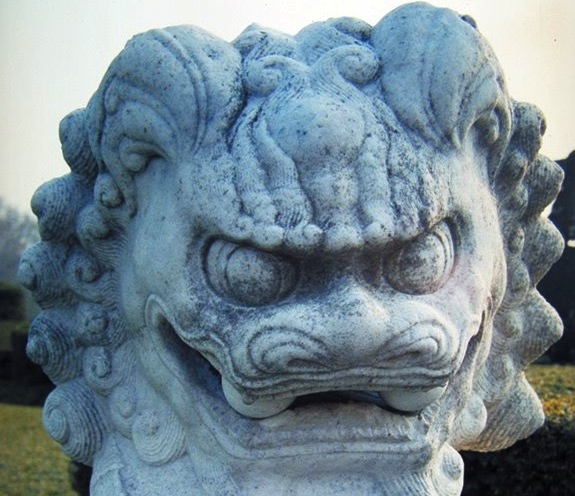【2001 Archives】
It Lurks
Arts & Culture

The creature in question, ostensibly terrifying.
Today is the Chinese New Year, and as you prepare to celebrate, I entreat you to remember the reason for the season. It’s a tale of not inconsiderable woe, and for this reason children are cautioned against reading it, though they’re also, paradoxically, commanded to heed it.
In the land called China, during a period called the shànggǔ—which translates roughly to “a very long time ago”—a fearsome creature-beast once roamed the land. It was known as the Nian, because rather than howling or roaring like your more conventional monster types, it emitted a cry that sounds like the Chinese word nián. Accounts of the beast’s appearance vary, but in many depictions, it resembles the stone lions sometimes seen outside Chinese restaurants: flat faced, with a dog’s body, prominent incisors, and a barrister’s powdered wig. Some have even described it as a lion with the heart of a bull. All of which suggests that it’s fairly effete and underwhelming, with very high blood pressure.
And yet it struck terror into the hearts of men. Every year on the night of the second full moon after the winter solstice, the Nian would come down from its home in the mountains to harass people and eat their chickens and children. In order to escape its wrath, the villagers would evacuate their homes and flee into the forest. This went on for centuries, presumably, until one year the people devised a plan. They sent an emissary up through the mountains into the Nian’s lair. Quaking with fear, he approached it and he said, “Nian, if you think you’re so big, go and kill all the other monsters in the world.”
And so it was that the Nian killed all the other monsters in the world.
The next year, it descended from the mountains again with the intention of harassing people and eating their poultry and progeny, as was its wont. But the feast was not to be. As the Nian approached the village, some children were wearing red and setting off firecrackers, as all good children should. It scampered away in horror.
The Nian, they learned that day, has a pronounced fear of loud noises and the color red. The people began at that time of year to put up red banners and papers and such, and also to set off firecrackers all the goddamn time. As the years passed, and as it became increasingly clear how utterly ineffectual the Nian was, this time became an occasion to gather with one’s family and revel in his defeat, basking in the joyous, mellifluous sound of constantly detonating firecrackers. This celebration came to be known as the Chinese New Year.
I’ve lived in China for five years, and I’m concerned to report that Chinese belief in the Nian is on the wane. There has not been a confirmed Nian sighting in China in living memory, and the current generation, having spent their lives ensconced in a vibrant cocoon of red things and loud noises, is inclined to see it as no more than a myth. The period surrounding the Chinese New Year, called Spring Festival, is, like Christmas in the West: increasingly adrift, unmoored from the events that gave rise to it and lend it meaning.
Granted, the Nian appears, even to a circumspect fellow such as myself, to be a pretty hapless monster. But my fear is this: that the intervening centuries have blunted our memories of its animus and that now, when so many consider it a legend, the Nian is prepared to make a comeback.
Think about it. China still protects itself, albeit unwittingly. But in the West, the second full moon following the winter solstice passes every year unnoticed, and no precautions whatsoever are taken against marauding creatures of the night. Too infrequently is it observed that outside China the Nian could easily pass unrecognized—mistaken for, depending on context and culture, say, a juvenile chupacabra, or the result of a genetic experiment gone moderately awry, or an old classmate. Not many of us in postindustrial society are raising chickens, which means the Nian is far more likely to prey on humans—on children, especially.
We are vulnerable. Our youth are at risk. I thus humbly beg you: Bar your doors! Hide your chickens! Make frequent percussive sounds! If you absolutely must go out, wear red and mace all leonine strangers in powdered wigs.
Beware the Nian!
Ben Flake lives in Suzhou, China, where he is vigilant.
Search
Categories
Latest Posts
New panda mom doesn't know she has twins thanks to sneaky zookeepers
2025-06-26 19:30D.C. police demand Facebook hand over data on Trump protesters
2025-06-26 19:29This stock photo of an 'over
2025-06-26 19:20Best robot vacuum deal from the Amazon Big Spring Sale
2025-06-26 16:53Popular Posts
How to Squeeze the Most Out of Your iPhone's Battery
2025-06-26 19:35D.C. police demand Facebook hand over data on Trump protesters
2025-06-26 19:02This was the most political Super Bowl ever
2025-06-26 19:00This new feature will change your YouTube life
2025-06-26 18:45Featured Posts
Today's Hurdle hints and answers for April 17, 2025
2025-06-26 19:36Nobel Prize stolen from social activist Kailash Satyarthi's house
2025-06-26 19:28Someone stole Tom Brady's Super Bowl Jersey last night
2025-06-26 18:19This space capsule looks so real that a NASA scientist reported it
2025-06-26 17:13Keeping Hope Alive
2025-06-26 17:12Popular Articles
How This Long
2025-06-26 19:35The top 20 employee benefits and perks, according to Glassdoor
2025-06-26 17:49Best IPL deal: Save $80 on Braun IPL Silk·Expert
2025-06-26 17:04Newsletter
Subscribe to our newsletter for the latest updates.
Comments (4273)
Information Information Network
Best robot vacuum deal: Save $320 on Shark Robot Vacuum and Mop
2025-06-26 19:13Style Information Network
China's largest internet company wants to give free internet to Indians
2025-06-26 19:12Progress Information Network
Julian Edelman's clutch, jaw
2025-06-26 18:20Opportunity Information Network
This new feature will change your YouTube life
2025-06-26 18:16Evergreen Information Network
How to Merge and Remove Duplicate Contacts in Android
2025-06-26 17:09